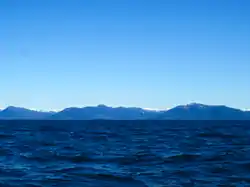Chatham Sound
Chatham Sound is a sound on the North Coast of British Columbia, Canada, bordering on Alaska, United States. It is located between the Dundas and Stephens Islands and the Tsimpsean Peninsula near Prince Rupert.[1] It is part of the Inside Passage and extends from Portland Inlet in the north to Porcher Island in the south.[2]
| Chatham Sound | |
|---|---|
| French: Bassin de Chatham | |
 Looking Northeasterly across Chatham Sound | |
 Chatham Sound | |
| Location | British Columbia, Canada, between Dundas Islands, Stephens Islands and Tsimpsean Peninsula |
| Coordinates | 54°22′30″N 130°35′30″W[1] |
| Primary inflows | Nass River, Skeena River |
| Primary outflows | Dixon Entrance, Hecate Strait |
| Surface area | 1,600 square kilometres (600 sq mi) |
It may have been named in 1788 by British Captain Charles Duncan after John Pitt, 2nd Earl of Chatham, who was First Lord of the Admiralty at that time.[1][2]
Geography
Chatham Sound is a semi-enclosed basin with an area of about 1,600 square kilometres (600 sq mi). It is connected to the open waters of the Hecate Strait and Dixon Entrance via several channels, such as Main, Brown, Hudson Bay, and Edye Passages. Along its southern end, the sound provides access to inland passages such as the Marcus and Arthur Passages, and the Grenville Channel beyond that.[3]
The two major rivers that drain into the sound are the Nass River (via the Portland Inlet) and Skeena River (via the Inverness and Marcus Passages). Because of the large inflow of fresh water the salinity of the sound is lower than the adjacent ocean.[3]
Hydrography
Most of Chatham Sound is less than 100 fathoms (600 ft; 180 m) deep, except in the northern part of the sound where depth exceeds 300 fathoms (1,800 ft; 550 m).[3]
Chatham Sound is an area of very large tides, with tidal ranges reaching peak values of 7.7 metres (25 ft) and an average tidal range of 4.9 metres (16 ft), tidal currents are proportionately strong, especially in the south and west areas.[4]
Ecology
As a result of tidal mixing, Chatham Sound is an area of particularly high primary productivity and highly concentrated phytoplankton biomass.[5] The sound has the largest diversity of shrimp species in the Pacific North Coast Integrated Management Area, with numbers dominated by humpback shrimp.[5] There are also major aggregations of Dungeness crab in the area.[5]
Once thought to be extinct, sponge reefs are now known to be a significant component of the sound floor. The largest cluster is now designated the Chatham Sound Reef Complex.[6]
See also
- Chatham Strait - nearby strait in the Alaska Panhandle, named after the first Earl of Chatham
References
- "Chatham Sound". BC Geographical Names.
- "Chatham Sound - inlet, British Columbia, Canada". www.britannica.com. Encyclopedia Britannica. Retrieved 25 April 2018.
- Ronald Wilmot Trites (September 1952). "The Oceanography of Chatham Sound, British Columbia" (PDF). www.oceanecology.ca. University of British Columbia. Retrieved 25 April 2018.
- Lin, Yuehua; Fissel, David (2018-07-06). "The Ocean Circulation of Chatham Sound, British Columbia, Canada: Results From Numerical Modelling Studies Using Historical Datasets". Atmosphere-Ocean. 56 (3): 129–151. doi:10.1080/07055900.2018.1473240. S2CID 133663475. Retrieved 2020-03-09.
- C.L. Clarke and G.S. Jamieson (2006). Identification of Ecologically and Biologically Significant Areas in the Pacific North Coast Integrated Management Area: Phase II – Final Report (PDF) (Report). Fisheries and Oceans Canada. Retrieved 2020-03-22.CS1 maint: uses authors parameter (link)
- Shaw, J; Conway, K W; Wu, Y; Kung, R (2018). Distribution of hexactinellid sponge reefs in the Chatham Sound region, British Columbia (Report). Geological Survey of Canada, Current Research (Online) 2018-1. doi:10.4095/306310.CS1 maint: uses authors parameter (link)
External links
![]() Media related to Chatham Sound at Wikimedia Commons
Media related to Chatham Sound at Wikimedia Commons